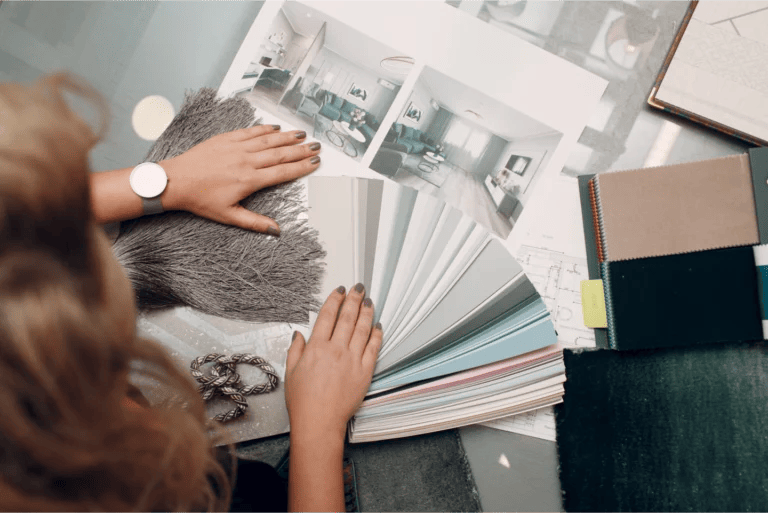Most interior designers start with creativity, not liability coverage. But somewhere along the way, the question comes up: Do interior designers need insurance?
If you’ve ever worked with clients, managed contractors, or carried your valuable tools to a site, you’re more than a designer — you’re a business owner. And every business needs protection.
By the end of this article, you’ll know exactly:
- How the right interior designer insurance helps you land bigger projects
- Which types of insurance interior designers need
- How insurance protects you from real risks on the job
- What coverage costs (it’s more affordable than you think)
You’ve built something amazing. Here’s how insurance helps you keep it that way.
The Real Risks Interior Designers Face
Interior design is personal. You work in clients’ homes and offices while juggling budgets, timelines, and unpredictable spaces. All of that behind-the-scenes activity and proximity to clients can pose serious financial risk for your business.
Even common claims faced by consultants and designers can put your business in a financial bind. Consider these examples:
A client trips over your sample bag during a walkthrough and fractures their hip. They bill you for the hospital visit and their time off work to recover.
Estimated cost: $7,500
A client claims your decorating choices for their hair salon don’t meet their vision. They sue you to recoup the costs of hiring another designer and the loss of business while they redecorate.
Estimated cost: $12,000
The flooring you chose doesn’t end up being durable enough for a high-traffic lobby. The client bills you for the replacement and reinstallation costs.
Estimated cost: $15,000
A contractor you recommended causes water damage in a client’s home. They blame you for recommending him and bill you for the repairs.
Estimated cost: $25,000
Even when you’ve done everything right, you can still be held responsible for things out of your control — we’re all human! That’s why experienced designers treat insurance as a must-have, not a maybe.
“A lot of newer designers assume insurance is unaffordable, but in my experience, you can’t afford not to have it. It’s a relatively small monthly expense, and one project more than covers it. It should be the first investment you make in your [design] firm.”
Courtney Batten, RID – Founder & Lead Interior Designer at Paige Studio (Dallas, TX)
Insurance doesn’t assume the worst. It simply gives you a safety net when the unexpected shows up, so one misstep doesn’t unravel all your hard work.

What Insurance Do Interior Designers Need (And Why It Matters)
There are a few key types of consultant insurance that could benefit interior designers. Which are right for you comes down to the kinds of risks you face while doing your job. Each type of insurance protects a different part of your business.
General Liability Insurance
General liability insurance covers injuries and property damage to others
Common Scenarios and How Insurance Helps
Movers you hired accidentally damage a client’s antique furniture.
General liability could cover repair bills and legal fees
A giant mirror you hung at a restaurant fell and injured some diners. The restaurant sues you for not securing it correctly.
This coverage can pay medical bills for physical injuries due to your services
You accidentally leave a candle burning in your rented studio, causing a fire.
This insurance can pay fire damage repair costs to spaces you rent.
You use a photo from Google images in your social media ad without permission. The image owner sues you for copyright infringement.
It also includes personal and advertising injury to help pay for lawsuits due to marketing mistakes.
Professional Liability Insurance
Professional liability insurance, also known as errors and ommisions (E&O), is designed to cover claims of negligence, missed deadlines, or unsatisfactory work.
Common Scenario and How Insurance Helps
A client claims your lighting plan caused delays and extra costs.
E&O helps cover your legal defense and settle the dispute.
Tools and Equipment Insurance
Tools and equipment insurance (also known as inland marine insurance) pays you back for damage or theft of design tools and materials.
Common Scenario and How Insurance Helps
Your business laptop is stolen from your car while you’re with a client.
Tools and Equipment can pay to replace the stolen laptop.
Cyber Liability Insurance
Cyber liability insurance is designed to cover the Theft of data you collected from clients (like contact info and payment details).
Common Scenario and How Insurance Helps
When your cloud storage is hacked, the thief sells your clients’ credit card details. You get hit with a data breach lawsuit.
Cyber liability pays defense costs, legal fees, and settlements to help your clients recover their stolen identities.
Fidelity Bonds
Fidelity bonds act as a promise of payment if your employee or contractor steals from a client.
Common Scenario and How Insurance Helps
An employee helping you with purchasing for a big corporate job misappropriates client funds.
A fidelty bond guarantees payment for the client’s losses (so you can keep their trust in your business intact).
Workers Compensation
Workers Compensation covers employee injuries on the job.
Common Scenario and How Insurance Helps
Your employee fell off a ladder while staging at the client’s house.
Workers comp can pay for the employee’s medical bills and physical therapy.
Additional Insureds
Additional Insureds are clients, landlords, and other people or companies who request to be added for protection under your policy in order to contract with you.
Common Scenario and How Insurance Helps
A real estate developer you’re partnering with experiences delays when you accidentally order the wrong fixtures.
Because the developer is an additional insured, your policy can help pay if they’re sued due to a mistake you made.
The insurance interior designers need comes down to which coverages fit their business. Every designer at every stage of business growth doesn’t have the same risks, and that’s okay.
Insurance isn’t about expecting the worst — it’s about giving yourself the freedom to focus on your best work, whatever that work is right now.
What Does It Cost? (Surprisingly, Less Than You’d Think)
At Insurance Canopy, interior design insurance with general liability and professional liability starts at just $21 per month. Check out our full breakdown of the cost of consultant insurance to learn more.
That means most interior designers can get insured for less than the cost of a couple of throw pillows each month. Here’s what $21 a month really gets you:
- A luxury candle OR protection if someone slips and hurts themself in your studio
- Two throw pillows OR protection if a client sues over design mistakes or disagreements
- One dinner out OR access to professional (and potentially high-paying) clients who require a Certificate of Insurance (COI)
How Insurance Helps You Say Yes to Bigger Projects
Insurance doesn’t just protect you, it positions you for growth. Here’s how:
- Builds trust with high-end clients who expect professionalism
- Meets vendor and contractor requirements for site access or collaboration
- Opens doors to commercial contracts that require proof of insurance
When you’re covered, you can confidently say “yes” to dream projects without worrying about what could go wrong.
“I decided insurance was non-negotiable when I landed my first six-figure kitchen remodel. I realized that if anything went wrong — damage, injury, or even a dispute over my design decisions — I didn’t have the funds to cover it. I could’ve lost everything.
Insurance gave me peace of mind and helped me show up more confidently as a professional.”
Lesley Myrick — Interior Designer & Owner of Lesley Myrick Art + Design (Atlanta, GA)

Objections, Fears, and What Insurance Can’t Do
Let’s get real: Even after reading all this, you might still be on the fence. Here are the most common concerns we hear from designers and honest answers that might help you decide.
“I’m not a big enough business for this.”
Here’s the thing: if you take on paid work, meet with clients, or handle valuable gear, you are a business. And do interior designing businesses need insurance if they’re small or working solo? Absolutely. The smaller your business, the more vulnerable you are to a single lawsuit or accident.
“I can’t afford it.”
It’s more affordable than most designers think. At just $21 per month, it’s cheaper than the cost of replacing one damaged light fixture (and way cheaper than a lawsuit!)
“Will it even cover what I do?”
Yes, if you choose the right policy. The best plans are designed specifically for creative professionals like you with general and professional liability. They account for the real-life risks you face and let you customize your coverage to what’s on your agenda, from site visits to dealing with subcontractors.
What insurance can’t do:
- It won’t undo a mistake or fix a tough client relationship.
- It won’t replace good communication or solid contracts.
Insurance can’t keep accidents from happening, but it can give you a financial safety net, peace of mind, and a more professional reputation in the industry.
Still have questions or concerns? We cover them all in this consultant insurance FAQ guide, with direct answers and practical tips for creative professionals like you.
How to Get Interior Designer Insurance Today (Without Headaches)
Getting reliable consultant insurance for interior design shouldn’t feel like a design emergency. Here’s how to do it, without the stress:
- Open your online insurance application
- Share a few quick details about your business (like your location, services, and revenue)
- Choose your coverage
- Get a quote
- Pay and download your proof of insurance (aka COI) instantly
You design things to last — why not set up your business for long-term success? Insurance doesn’t mean you expect things to go wrong. It just means you’re smart enough to be ready if they do. Remember: you don’t need to be perfect. You just need to be prepared.

Common Questions About Interior Designer Insurance
Can interior designer insurance cover subcontractors or assistants?
Not by default, unless they are added as additional insureds under your policy. Most policies only cover the named insured — you — and your employees automatically.
If you work with non-employee assistants, freelancers, or subcontractors, they typically need their own insurance. This keeps everyone properly covered and reduces the risk of liability being passed back to you.
Can I get interior designer insurance if I work from home or part-time?
Yes, Insurance Canopy interior designer insurance also supports part-time and remote designers. You’ll still want coverage for virtual consults, advertising, site visits, and equipment loss
If you regularly share digital files or store client data, consider adding cyber liability coverage for protection against data breaches or cyberattacks, even if you’re just working from your laptop at home.
Is interior designer insurance legally required?
Legally, no. However, COIs are often contractually required by clients (especially commercial or high-end residential), property managers, landlords, or vendors.
Even if no one’s asking for it yet, having insurance protects your reputation, your finances, and your ability to take on bigger, higher-value projects with confidence.





